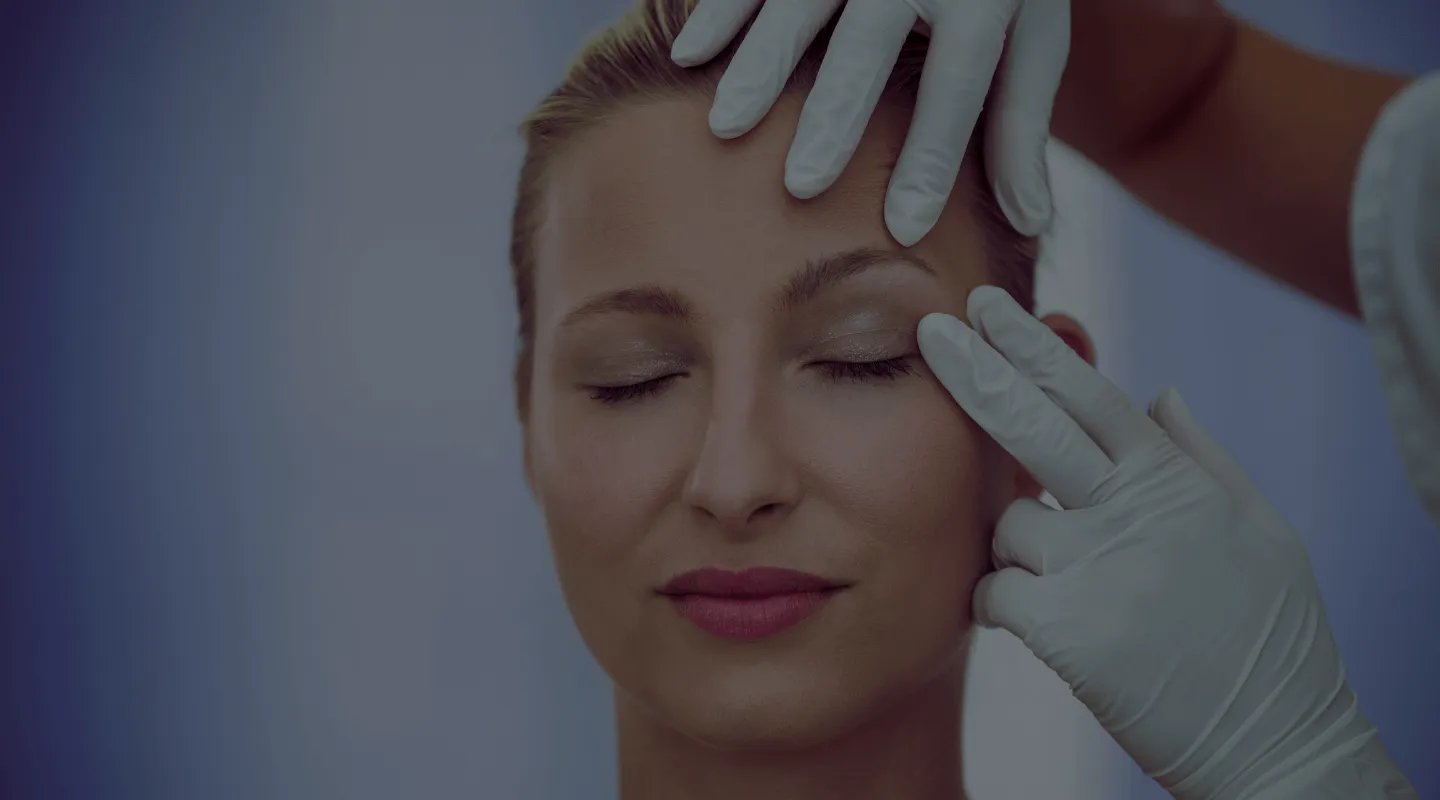
Blepharoplasty
Your affordable eyelid surgery in Tunisia
Say goodbye to droopy eyelids and under-eye bags and rediscover a refreshed and rested look.
How does it work?
What is Blepharoplasty in Tunisia?
Blepharoplasty is a procedure that removes excess skin from the eyelids and the fatty hernias that form the eyelid bags. Blepharoplasty can be performed alone or in combination with other facial rejuvenation procedures. In certain cases, this procedure may have a functional value and not just an aesthetic one.
What are the indications for blepharoplasty?
Generally, blepharoplasty is recommended to treat various eye problems such as:
- Under-eye bags due to fat accumulation around the orbit,
- Droopy eyelids that give a sad and tired appearance,
- Excess skin covering the eyelid crease,
- Dark circles and hollows around the eyes,
- Crow’s feet, and skin laxity.
Furthermore, it is also indicated in cases of eyelid swelling that can cause discomfort such as redness, tearing, or narrowing of the visual field.
What is the average price of blepharoplasty in Tunisia?
The costs of a blepharoplasty procedure in Tunisia can vary depending on the specific difficulty of the procedure. In general, the average cost is €1600 and includes all expenditure items (plastic surgeon, anesthetist, operating room, hospitalization, nursing staff, dressings, and post-operative checkups). Nevertheless, the prices of blepharoplasty in Tunisia remain much more competitive than those in European and American countries. Choosing Tunisia for your blepharoplasty means saving on your procedure while benefiting from the highest standards of hygiene, quality, and professionalism.
Your health, our priority.
Request your free quote.
How does blepharoplasty surgery proceed?
This operation requires pure local anesthesia or combined with sedation. To begin, the surgeon makes incisions at the natural crease of the upper eyelid or below the edge of the lower eyelid. Subsequently, the excess skin and fat is removed, and the incisions are closed with very fine stitches. Note that if only fat is present in the lower part of the eyelid, it could be removed by a laser incision inside the lower eyelid, without any external incision or scar (transconjunctival blepharoplasty). In this case, there will be no scars or stitches.
What care is needed during the post-operative period of blepharoplasty?
Minor post-operative discomfort is controlled by oral medication. If bruising and light sensitivity occur, they may last for one or two weeks. Similarly, swelling will gradually disappear after one or two weeks. Eye shadow can be applied as soon as the stitches are removed after 3 to 5 days. Blepharoplasty after 10 days. Contact lenses can usually be worn again after 7 to 10 days. The scar on top will gradually disappear in the months following the operation.
Don’t worry if, in certain areas like near the nose or under the eyebrows, the scar is more visible or causes symptoms such as itching, minor pain, or simulates the presence of a subcutaneous cyst, this is all normal and will disappear. To help resolve these inconveniences, you can perform a light 5-minute massage 3 or 4 times a day.
How is a Genioplasty Performed?
Genioplasty surgery requires local anesthesia and sedation and takes about 50 minutes. Depending on the patient’s chin structure, there are two different surgical techniques.
Reduction Genioplasty in Tunisia
Reduction genioplasty aims to reduce the chin. To begin, the surgeon makes incisions inside the mouth and, using a micromotor, reshapes the bone structure according to the overall proportions of the face and the patient’s requests. Finally, the surgeon closes the incision and applies an external dressing to support the operated area.
Advancement Genioplasty in Tunisia
In the case of advancement genioplasty, silicone implants are used. Like reduction chin surgery, incisions are made inside the oral cavity. Then, the silicone support structures are inserted and correctly positioned. This allows for redesigning the facial profile, replacing a barely visible chin. In this case as well, an additional external support dressing will be applied.
What are the rules to follow for good healing?
After blepharoplasty, rigorous eye hygiene must be maintained by regularly washing the eyes. Here are some tips you will receive after your blepharoplasty:
- First, using cold compresses or ice can help reduce swelling.
- Then, sleep with your head elevated using two pillows for at least a week.
- Furthermore, limit exposure to activities such as watching television or reading.
- Alcohol should not be consumed.
- Avoid using contact lenses until complete healing.
- Finally, when going outdoors, wear sunglasses.
Blepharoplasty Before and After: Results
This procedure has a high degree of satisfaction regarding its results. Normal post-operative swelling will normally resolve in a few weeks, and the scar (linear and fine) will continue to fade until it is aesthetically irrelevant. The result should be considered permanent because reforming imperfections is difficult and in any case requires a very long period of time.
What are the potential risks and complications associated with blepharoplasty?
After blepharoplasty, patients may experience symptoms such as tearing, itching, burning eyes, dryness, light sensitivity, and diplopia or blurred vision, which may persist for several days. These inconveniences can be alleviated by following behavioral rules and applying a good lubricating eye drop. Some eyelid swelling is also part of the normal temporary consequences. A complication of blepharoplasty, although certainly infrequent, is difficulty completely closing the eyes during sleep, which is due to abnormal scarring. For the same reason, in a small percentage of patients, asymmetry of results may be evident.
Other risks are those commonly present in all surgical procedures, thus associated with the use of anesthetics. By following the appropriate pre- and post-operative prescriptions and indications, most risks are easily avoided and prevented, or at least minimized. The pre-operative assessment also aims to assess whether the patient is a good candidate for this type of surgery. Therefore, the best prevention is to consult a plastic surgeon with efficient staff!
Non-Surgical Blepharoplasty in Tunisia
This technique uses injectable fillers to fill the volume in the tear trough area between the lower eyelid and the cheek. As we age, the fat in the central and upper areas of the cheeks becomes lower and narrower. This gives the face a tired look, as a dark shadow falls into the cavity left by the lost fat. This is what is called “under-eye circles.” Some people have a greater genetic predisposition, but it happens to almost everyone over the years.
Injecting hyaluronic acid into this area is a very effective remedy to correct a tired look and eliminate most “under-eye circles.” Note that this technique is not indicated for those who have a lot of swollen fat inside the lower eyelid or if the hollows are very marked. In the first case, the indicated operation is blepharoplasty and fat repositioning, while in the second, fat injection will fill the lost volume.
With the arrival on the market of more durable and effective injectable fillers, non-surgical alternatives to normal cosmetic operations have finally become possible. Non-surgical blepharoplasty takes about 10 minutes, is painless (with the application of a cream that numbs the area), and bruising is almost non-existent or minimal. Most people return to work immediately. The results last 18 months or more.
Our advantages


Combining Blepharoplasty with Other Cosmetic Surgeries
Most often, patients from abroad who come to have surgery in Tunisia opt for several cosmetic surgery procedures. In this sense, blepharoplasty is often combined with a face lipo-filling or a facelift, but also with a breast lift or liposuction. Do not hesitate to contact us for more information on combining cosmetic surgeries.
Contact and Quote Request for Blepharoplasty in Tunisia
Our team is always at your disposal to assist and guide you through all the procedures for blepharoplasty in Tunisia. If you are tempted to have your blepharoplasty abroad and you wish to organize your stay in Tunisia with a serious and experienced agency, trust the professionals of Tunisia Destination Santé. We accompany you step by step in the preparation of your file and the organization of your stay. Do not hesitate to contact us for more information and to request a free, non-binding quote.
Frequently Asked Questions
Is it possible to have blepharoplasty without visible scarring?
Generally yes, it is possible to perform blepharoplasty without visible scarring. Modern techniques allow for incisions inside the eyelids (transconjunctival blepharoplasty) or hiding incisions in the natural skin creases. This reduces the visibility of scars.
Can blepharoplasty improve vision?
Indirectly, yes. If excess skin on the upper eyelid obstructs the visual field, blepharoplasty can remove this excess skin and thus improve peripheral vision. Note that this does not correct internal vision problems such as myopia or hyperopia.
What are the specific risks of blepharoplasty for contact lens wearers?
Contact lens wearers must be particularly cautious after blepharoplasty, as surgery can lead to dry eyes and increased sensitivity. Avoid wearing lenses for a period after the procedure and follow your surgeon’s advice.
Can blepharoplasty correct under-eye circles?
Lower blepharoplasty can help reduce the appearance of dark circles by removing or repositioning fat pouches and tightening the skin under the eyes. However, it cannot correct dark pigmentation, which may require additional treatments such as chemical peels or lasers.
Are there non-surgical alternatives to blepharoplasty?
Yes, there are non-surgical alternatives such as filler injections to add volume, laser treatments to tighten the skin, and chemical peels to improve skin texture and pigmentation. These options may offer improvements, but they are not as durable or effective as blepharoplasty.
Is blepharoplasty suitable for young patients?
Although blepharoplasty is more commonly performed in people aged 40 and over, younger patients can also benefit from this procedure in cases of genetic predispositions to droopy eyelids or under-eye bags. A surgeon’s evaluation is essential to determine the suitability of the procedure.
What is the typical recovery time after blepharoplasty?
In general, initial recovery after blepharoplasty takes one to two weeks, during which patients may experience swelling, bruising, and some sensitivity. However, final results may take several months to appear, once all swelling has subsided.
Can blepharoplasty affect the appearance of eyebrows?
Indirectly, yes. Blepharoplasty can give the appearance of higher eyebrows by removing excess skin from the upper eyelids, which can “open” the eyes. However, for more pronounced eyebrow changes, a specific procedure such as an eyebrow lift may be necessary.
Is it possible to combine blepharoplasty with other cosmetic procedures?
Yes, it is common to combine blepharoplasty with other cosmetic procedures, such as a facelift, rhinoplasty, or Botox injections. This allows for maximizing aesthetic results while minimizing overall recovery time.
A revision may be necessary if the initial results are unsatisfactory, but also if asymmetries develop, or if complications such as eyelid retraction or persistent dry eyes occur. In this case, a consultation with an experienced surgeon is essential to assess the need for a revision.
